Island Stories:
![]() Danzig
Mine
Danzig
Mine
![]() Zeballos
Iron Mine
Zeballos
Iron Mine
![]() Conuma
Peak 1910
Conuma
Peak 1910
Alexandra Peak
Argus Mountain
Bate/Alava Sanctuary
Beaufort Range
Big Interior Mtn
Big Interior Mtn 1913
Part 1
Part 2
Bolton Expedition 1896
Cliffe Glacier
Clinton Wood
Comox Glacier
Comox Glacier 1922
Comox Glacier 1925
Comstock Mtn
Conuma Peak
Copper King Mine
Crown Mtn
Elkhorn 1912
Elkhorn 1949
Elkhorn 1968
Eugene Croteau
Golden Bullets
Golden Hinde 1913/14
Golden Hinde 1937
Golden Hinde 1983
Harry Winstone Tragedy
Jack Mitchell
Jim Mitchell Tragedy
John Buttle
Judges Route
Koksilah's Silver Mine
Landslide Lake
Mackenzie Range
Malaspina Peak
Mariner Mtn
Marjories Load
Matchlee Mountain
Mount McQuillan
Mt. Albert Edward
Mt. Albert Edward 1927
Mt. Albert Edward 1938
Mt. Becher
Mt. Benson 1913
Mt. Benson
Mt. Doogie Dowler
Mt. Colonel Foster
Mt. Hayes/Thistle Claim
Mt. Maxwell
Mt. Sicker
Mt. Tzouhalem
Mt. Whymper
Muqin/Brooks Peninsula
Nine Peaks
Queneesh
Ralph Rosseau 1947
Rosseau Chalet
Ralph Rosseau Tragedy
Rambler Peak
Red Pillar
Rex Gibson Tragedy
Sid's Cabin
Steamboat Mtn
Strathcona Park 1980's
The Misthorns
The Unwild Side
Victoria Peak
Waterloo Mountain 1865
Wheaton Hut/Marble Meadows
William DeVoe
Woss Lake
You Creek Mine
Zeballos Peak
Other Stories:
Sierra
de los Tuxtlas
Antarctica
Cerro del Tepozteco
Citlaltepetl
Huascaran
Mt. Roraima
Nevada Alpamayo
Nevada del Tolima
Nevado de Toluca
Pico Bolivar
Popocatepetl
Uluru/Ayers Rock
Volcan Purace
Volcan San Jose
Biographies
Island 6000
Cartoons
Order the Book
Contact Me
Links

Popocatepetl:
The
Smoking Mountain
by Lindsay Elms
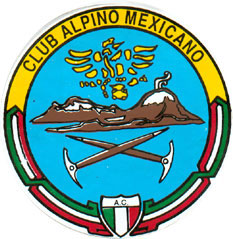 By
late morning the polluting smog that envelops the high plateaus and valleys
around Mexico City rises and blocks out the view of two snow capped peaks
that ascend to nearly 18,000 feet to the southeast of the capital city.
Popocatepetl and Iztaccihuatl are respectively the second and third highest
mountains in Mexico. These two peaks are part of the range called the
Sierra Volcánica Transversal which extend from the Gulf of Mexico
in the east to the Pacific Coast in the west. This range intersects with
the southern end of the Sierra Madre Occidental and the Sierra Madre Oriental,
two long cordilleras that run down either side of the country from its
border with the United States. These three mountain ranges have been thrust
up by tectonic plate action and where they converge immense amounts of
subterranean heat are generated creating the greatest altitude of volcanoes
in the country. At this intersecting plain also sits Citlaltepetl (Pico
de Orizaba,) Xinantecatl (Nevado de Toluca) and Matlalcueyetl (La Malinche,)
respectively the highest, forth and fifth highest mountains in Mexico.
They too form the chain of volcanoes around Mexico City.
By
late morning the polluting smog that envelops the high plateaus and valleys
around Mexico City rises and blocks out the view of two snow capped peaks
that ascend to nearly 18,000 feet to the southeast of the capital city.
Popocatepetl and Iztaccihuatl are respectively the second and third highest
mountains in Mexico. These two peaks are part of the range called the
Sierra Volcánica Transversal which extend from the Gulf of Mexico
in the east to the Pacific Coast in the west. This range intersects with
the southern end of the Sierra Madre Occidental and the Sierra Madre Oriental,
two long cordilleras that run down either side of the country from its
border with the United States. These three mountain ranges have been thrust
up by tectonic plate action and where they converge immense amounts of
subterranean heat are generated creating the greatest altitude of volcanoes
in the country. At this intersecting plain also sits Citlaltepetl (Pico
de Orizaba,) Xinantecatl (Nevado de Toluca) and Matlalcueyetl (La Malinche,)
respectively the highest, forth and fifth highest mountains in Mexico.
They too form the chain of volcanoes around Mexico City.
All these peaks are of volcanic origin, however, of these five peaks it is only Popocatepetl that is active and it is the volcanic activity that has brought about its climbing history. Before the arrival of the Spanish conquistadors, the Aztec emperor Moctezuma sent ten of his strongest warriors up the mountain to find the source of the smoke. Two of them died on the ascent while the rest reached the summit and saw the smoke belching from fissures within the crater. On the descent, another six perished from the cold, however, two managed to report what they had seen to Moctezuma but never recovered their pre-summit health.
The first European ascent of Popocatepetl happened in 1522 and marks the highest summit climbed by Europeans up to that time. The Spanish conqueror, Hernando Cortés, on his trek through Mexico, crossed the pass (Paseo de Cortés) between Popocatepetl and Iztaccihuatl and saw the Aztec capital of Tenochtitlán located where modern Mexico City is now situated. After his brutal conquest of the Aztecs, Cortés found himself in need of sulfur to replenish his supply of gunpowder. He dispatched a party of soldiers led by Francisco Montaño to climb Popocatepetl and obtain the material from the crater. They found the ascent trying due to the cold, temperatures they were not use too in the lower altitudes, but managed to reach the top. To acquire the sulfur, Montaño had to be lowered on a rope down the cliffs surrounding the crater. Despite his fears of falling and going straight to hell, he and his men managed to get hold of a supply of the badly needed yellow powder and return alive.
To the Aztecs, Popocatepetl is revered as one of the most important of their sacred mountains. Its rich volcanic soil combined with a congenial climate and plentiful water to make its lower slopes one of the most fertile and heavily populated areas of Pre-Columbian Mexico. The closer the maize grew to the mountain, the earlier it ripened and the better it tasted. Despite the mountains wrathful nature it represented to many Aztecs divine embodiment of all that was good and desirable.
The irony is that Cortés used a substance from the Aztec's sacred mountain to make gunpowder for killing people for the greater glory of the Spanish empire. At the same time the Aztecs performed their own bloodthirsty human sacrifices as a worship to the mountain.
In Nahuatl, the ancient language of the Aztecs, Popocatepetl means "smoking mountain" while neighbouring Iztaccihuatl means "sleeping woman." The close physical proximity of these two mountains has brought about a popular legend.
According to the widely held legend, Popocatepetl was a warrior of an Aztec tribe who fell in love with Iztaccihuatl, the daughter of the tribal chief. When the two lovers went to her father to ask to be allowed to marry, he told them he would only agree to their marriage if Popocatepetl would first conquer an enemy tribe and bring him the head of its leader. The young warrior succeeded in his mission, but he took so long that Iztaccihuatl, thinking he had perished, succumbed to sorrow. When Popocatepetl eventually returned triumphant, he found Iztaccihuatl dead, so he picked her up and carried her to the top of a mountain. He laid her along the summit ridge where she assumes the form of a sleeping woman - the shape many people see in the outline of Iztaccihuatl today. Popocatepetl lit a torch and stood watch over his lover, which accounts for the smoke that issues from the mountain that bears his name.
The ascents of Popocatepetl
by Moctezuma's soldiers and Francisco Montaño were not considered,
at the time, mountaineering feats, however, mountaineering as a sport
took on a new meaning in the mid 1800's with the ascent of all the big
peaks in the European Alps. Eventually, mountaineers began going abroad
seeking new adventures. Mountaineers such as Edward Whymper, Matthias
Zurbriggen and Edward Fitzgerald visited the mountains of New Zealand,
Canada, South America and Mexico making their mark with first ascents
of many previously unclimbed mountains. In the mid 1900's, with the convenience
of cheap air travel and the advent of modern climbing techniques and equipment,
contemporary mountaineers sought out the challenges of not only the lofty
Himalayas, but also many exotic mountains including the Mexican volcanoes.
These volcanoes have since become a popular destination, especially for
North American's, seeking their first taste of high altitude mountaineering.
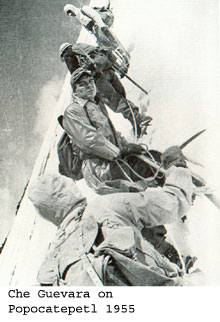 Technically
there is nothing difficult about climbing Popocatepetl and many people
have reached its summit including the Argentine revolutionary Ernesto
(Che) Guevara. Guevara made an attempt in July with some of his Cuban
friends but returned and summited on October 12, 1955. For Guevara, who
suffered severely from asthma, the climb, which to him meant the summit,
was the ultimate challenge. It was to prove his strength of mind and determination.
As a revolutionary, and a climber, Guevara had the "to the summit
or bust" attitude that we see in a few strong-minded Himalayan mountaineers.
For them the goal must be achieved. Death is a natural consequence that
they are willing to accept as we can see in Che's writing in a letter
to his mother on July 20, 1955:
Technically
there is nothing difficult about climbing Popocatepetl and many people
have reached its summit including the Argentine revolutionary Ernesto
(Che) Guevara. Guevara made an attempt in July with some of his Cuban
friends but returned and summited on October 12, 1955. For Guevara, who
suffered severely from asthma, the climb, which to him meant the summit,
was the ultimate challenge. It was to prove his strength of mind and determination.
As a revolutionary, and a climber, Guevara had the "to the summit
or bust" attitude that we see in a few strong-minded Himalayan mountaineers.
For them the goal must be achieved. Death is a natural consequence that
they are willing to accept as we can see in Che's writing in a letter
to his mother on July 20, 1955:
I took the Popo by assault, but despite much heroism, I was unable to reach the top. I was ready to die for it, but my Cuban climbing companion scared me because two of his toes froze… We spent six hours fighting the snow that buried us to our waist, and with feet totally drenched since we lacked the proper equipment. The guide got lost in the fog skirting a crevass, and we were exhausted from the soft and unending snow. The Cubans won't climb again, but for me, as soon as I have some money, I will challenge the Popo again ...
In 1988 it was my turn to make an ascent of the famous volcano. On the morning of October 19, Geoff Mahan and I left our hotel in Mexico City and took a bus to the small town of Amecameca. After picking up a few last minute supplies at the local supermarket we then arranged for a taxi to take the two of us up to the hotel at Tlamacas. Tlamacas being a popular destination not only for climbers but also for Mexican tourists to see the volcano up close and to take short hikes on the lower slopes. Once at the hotel we enquired about the condition of the huts higher up on the mountain and found there was no water available. Since we didn't have containers for carrying any extra water we decided to take a bunk in the climbers hostel adjacent to the hotel.
Although Geoff and I had spent four months climbing throughout the Andes of South America we found that in the last month of traveling in Central America we had lost much of our acclimatization. That afternoon we went for a walk up the trail to about 4,500 metres to familiarize ourselves with the route as we would be leaving the hostel in the early hours of the next morning for the summit. That evening we cooked our dinner outside and stared up at the mountain with the usual excitement before a climb.
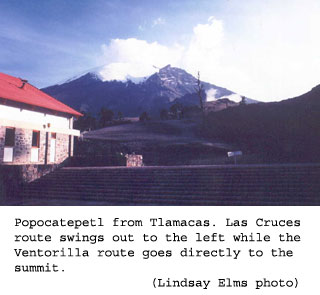 At
3 A.M. our alarms went off. We had not really slept due to the altitude
and our excitement but we were well rested. A light breakfast, a hot drink
and by 3:50 our packs were on our shoulders and with the aid of our headlamps
we began hiking up the trail of the Ventorillo Route. It felt good to
be back in the mountains climbing a peak that we had read and dreamt about
for many years. As we steadily gained altitude the dawning sun caressed
the eastern slope of the mountain while to the west a huge shadow in the
shape of the volcano materialized over the surrounding plains. At 4,630m
we passed the Quentano Hut and then at 4,900 we arrived at the Ventorillo
Hut. It had taken us three hours to reach the hut so we stopped for a
short break. Not far beyond the hut we decided it was time to take off
our running shoes. Climbing the scree trail was less tiring in our running
shoes but now that we had arrived at the frozen snow it was time to put
on climbing boots and crampons. Snow conditions were perfect as we gradually
made our way up the thirty-five degree slopes towards the summit.
At
3 A.M. our alarms went off. We had not really slept due to the altitude
and our excitement but we were well rested. A light breakfast, a hot drink
and by 3:50 our packs were on our shoulders and with the aid of our headlamps
we began hiking up the trail of the Ventorillo Route. It felt good to
be back in the mountains climbing a peak that we had read and dreamt about
for many years. As we steadily gained altitude the dawning sun caressed
the eastern slope of the mountain while to the west a huge shadow in the
shape of the volcano materialized over the surrounding plains. At 4,630m
we passed the Quentano Hut and then at 4,900 we arrived at the Ventorillo
Hut. It had taken us three hours to reach the hut so we stopped for a
short break. Not far beyond the hut we decided it was time to take off
our running shoes. Climbing the scree trail was less tiring in our running
shoes but now that we had arrived at the frozen snow it was time to put
on climbing boots and crampons. Snow conditions were perfect as we gradually
made our way up the thirty-five degree slopes towards the summit.
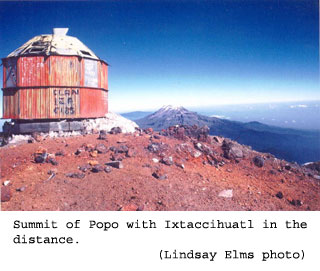 Just
before 9 A.M. we arrived on the summit and were greeted with an incredible
view. The sky was clear blue and the outlines of Pico de Orizaba and Iztaccihuatl
stood sharp and impressive. In the valley's below the smog was already
beginning to build as Mexico City came alive. Having looked into many
craters over the years it still never fails to impressive me when I look
down into another one. Below the craters virtually sheer walls was another
smaller crater and inside that one was a small blue lake. Belching out
of fissures on the crater wall steam and smoke periodically shot upwards
and the strong smell of sulfur permeated our nostrils. Neither of us talked
about being concerned if an unexpected eruption from the Aztec Warrior
were to take place. We were just basking in the glory of being on the
summit of such a beautiful mountain.
Just
before 9 A.M. we arrived on the summit and were greeted with an incredible
view. The sky was clear blue and the outlines of Pico de Orizaba and Iztaccihuatl
stood sharp and impressive. In the valley's below the smog was already
beginning to build as Mexico City came alive. Having looked into many
craters over the years it still never fails to impressive me when I look
down into another one. Below the craters virtually sheer walls was another
smaller crater and inside that one was a small blue lake. Belching out
of fissures on the crater wall steam and smoke periodically shot upwards
and the strong smell of sulfur permeated our nostrils. Neither of us talked
about being concerned if an unexpected eruption from the Aztec Warrior
were to take place. We were just basking in the glory of being on the
summit of such a beautiful mountain.
After nearly an hour on the summit we decided it was time to head back down to Tlamacas. We discussed the two descent routes, the Ventorillo and Las Cruces, and decided to walk around the crater and descend the easy Las Cruces. We knew that we could have quickly descended the route we climbed because it was such a direct route to the summit but with it being only mid morning we chose to explore the mountain. After circumventing the crater we dropped down on to the Las Cruces trail passing many climbers still on their way to the summit. Although the path was very gentle and easy we kept thinking that it would have been an unpleasant climb because of the loose scree and the extra distance the trail takes as it winds around the mountain. Several places we stopped to lay down and rest and take in the view but by 12:30 we were back at the hostel taking on badly needed fluids.
Over the years since I climbed the mountain I have continued to follow the story of Popocatepetl and its increasing volcanic action. This stratocone volcano is one of Mexico's most active volcanoes and more than thirty million people live within view of the volcano. Major eruptions about 5,000, 2,000 and 1,000 years ago produced widespread tephra fall, pyroclastic flows on all flanks of the volcano and lahars that buried villages.
In 1992 the mountain began showing an increase in seismic activity and a noticeable increase in fumarolic activity in the summit crater. Throughout 1995 and early 1996, Popocatepetl produced occasional phreatic explosions accompanied by intermittent low-magnitude seismicity and anomalously high emissions of SO2. By the end of March, a new lava dome was identified in the summit crater indicating that a magmatic phase of the current eruptive episode had begun. Finally, on April 30, 1996, an explosion of the new dome killed five climbers who were at the summit and did not heed warnings that closed the volcano to climbers. They are the only casualties to date.
Over the next year occasional moderate eruptions sent columns of volcanic ash several kilometers into the air but on June 30, 1997, Popocatepetl threw ash twelve kilometers into the air during its largest eruption since 1925. The falling ash fell over Mexico City seventy-two kilometers away and caused the shut down of the international airport for fourteen hours.
Up until April 2003, Popocatepetl has continued to remain active. Pyroclastic
flows have halted eight kilometers from the town of Santiago Xalitzintla
and caused some melting of the summit glacier. Surrounding villages and
towns such as Amecameca and Santiago Xalintzintla have been on high alert
(Alert Level Yellow Phase III) and the road up to the Paseo de Cortés
and the hotel at Tlamacas has been closed. Those wishing to climb the
mountain have had to seek alternate destinations.
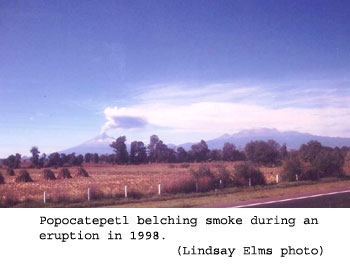 Volcanologists
try to predict when the mountain will erupt using data collected over
the years and from studying similar types of volcanoes, but ultimately
the mountain has a mind of its own. Those living within reach of the outfall
are willing to accept the risk as they have chosen to live within the
shadow of the volcano. For mountaineers, the volcano will be continue
to attract a certain breed of climber fascinated with the challenge of
ascending the slopes to look into another summit crater and to play roulette
with the forces of nature. When Popocatepetl vents its anger, maybe it
is just the Aztec Warrior letting out a heavy sigh as he remembers the
loss of his beloved Iztaccihuatl.
Volcanologists
try to predict when the mountain will erupt using data collected over
the years and from studying similar types of volcanoes, but ultimately
the mountain has a mind of its own. Those living within reach of the outfall
are willing to accept the risk as they have chosen to live within the
shadow of the volcano. For mountaineers, the volcano will be continue
to attract a certain breed of climber fascinated with the challenge of
ascending the slopes to look into another summit crater and to play roulette
with the forces of nature. When Popocatepetl vents its anger, maybe it
is just the Aztec Warrior letting out a heavy sigh as he remembers the
loss of his beloved Iztaccihuatl.
How to order | | About the Author || Links || Home
Contact:
Copyright ©
Lindsay Elms 2001. All Rights Reserved.
URL: http://www.beyondnootka.com
http://www.lindsayelms.ca